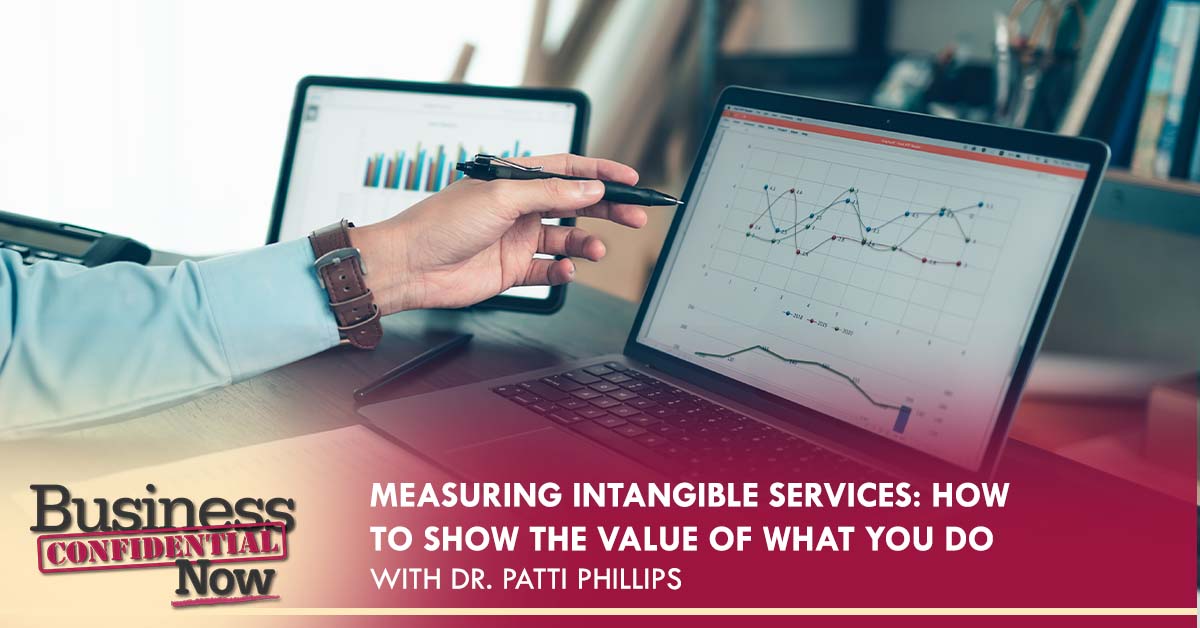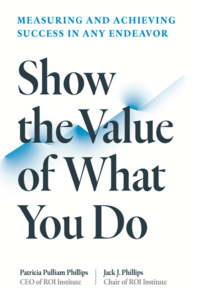
Photo Credit: © iStock | Charnchai
Measuring intangible services, like the value of advice from a doctor or lawyer, can be daunting. It’s often the measure that can determine whether a business treats such advice or service as a nice-to-have discretionary cost or a must-have investment in the organization’s future success. What factors determine which column it falls in?
In today’s episode, Dr. Patti Phillips, CEO of ROI Institute, Inc., shares her tremendous insight into measuring intangible services that can help those who provide services show the value of what they do. She also shares that we must look at the value of what we do in terms of the chain of impact.
So if we offer a service to people, we should make them consider the service we deliver is valuable. So if you want to hear more of Dr. Patti Phillips, hit that play button and tune in to this episode of Business Confidential Now!
What You’ll Discover About Measuring Intangible Services
- How you can measure intangible services
- How to remove subjectivity from the process when measuring intangible services
- How to start showing the value of your intangible services
- The levels of the chain of impact and how it’s going to help the community
- The sticking point that gets us derailed measuring intangible services or showing the value of what we do
Guest Bio
 Dr. Patti P. Phillips, CEO of ROI Institute, Inc., is a renowned leader in measurement and evaluation. Patti helps organizations implement the ROI Methodology® in more than 70 countries worldwide.
Dr. Patti P. Phillips, CEO of ROI Institute, Inc., is a renowned leader in measurement and evaluation. Patti helps organizations implement the ROI Methodology® in more than 70 countries worldwide.
—
Measuring Intangible Services: How To Show The Value Of What You Do With Dr. Patti Phillips
Measuring intangible services, the value of advice from, let’s say, a good engineer, architect, accountant, doctor, lawyer or any service provider you can think of, can be a daunting task. Yet, it’s often the measure that can make the difference between whether a business treats such advice or service as a nice-to-have discretionary cost or a must-have investment in the organization’s future success. What factors determine which column it falls in? Our guest has tremendous insight into measuring intangible services that can help both those who provide services show the value of what they do and those who need help justifying the benefits they receive.
—
I have a terrific guest for you. She is Dr. Patti Phillips, a renowned leader in measurement and evaluation and the CEO of ROI Institute, who’s helped organizations in more than 70 countries implement the trademarked ROI Methodology. In a nutshell, she can show you how to measure and improve the success of any type of project, program or initiative in whatever type of work you do.
She’s also the author of the book, Show the Value of What You Do. Whether it comes to performance reviews or landing new business, showing the value of what you do is important, especially if your work produces intangible benefits that are tough to quantify. I am dying to learn more. Welcome to the show, Patti.
Thank you. It’s a pleasure to be here.
It’s a privilege to have you on the show because showing the value of what you do when your business or career is in a service sector can be difficult when the person you are talking to is looking for a straight line between the cost of your intangible service and a very measurable benefit to their bottom line. How do you go about measuring intangible services? Where do you start?
We are fortunate to have been working with this process for many years. We’ve had the opportunity to look at all types of different programs, projects, and businesses. It starts with why. “Why are you doing what you are doing in the first place?” and getting clarity around that why. When we talk about intangibles, typically intangible outputs or intangible outcomes are those measures that we are not converting to money necessarily. They tend to be more subjective in nature than objective. Whereas the more tangible, we can count those. To look at those, we have to get clear on why we are doing it.
An example, in the service sector, maybe you are trying to appease your customers or deliver better customer value. Sometimes that’s hard to measure because what is it? How do you know you need to do that? What is happening or not happening that needs to change that will give or offer up that greater customer value? What do you mean by customer value in the first place? Do you have complaints? Are you trying to increase the number of customers? Is it the market share you are looking for? It’s about defining what you mean.
You mentioned before that there’s subjectivity in this. How do you remove subjectivity from the process when measuring intangible services?
There’s subjectivity in everything. When we talk about Math, 1 plus 1 is 2 unless you want to be wrong. The question is, “From where do the 1 and the 1 come?” There’s always subjectivity in everything that we do. It’s about the clarification. We can remove subjectivity by considering the source, even though there’s subjectivity there or by being more specific in the questions that we are asking and the measures that we are taking. We can remove subjectivity by having a process and being able to explain what, how, and why we are doing that way. For example, we have a process, it was Edwards Deming who said, “If you can’t explain what you do as a process, you don’t know what you are doing.”

Measuring Intangible Services: Remove subjectivity by having a process and explaining what you’re doing, how you’re doing it, and why you’re doing it that way. If you can’t explain what you do as a process, you don’t know what you’re doing.
It’s all about the process. It’s exactly what you are going to do. That process also helps you explain exactly what you did once it’s done so that it can be replicated in the future. We have a process. We start with why we are doing it. We get clarity around the needs. If it’s focused on the customer or employee, whatever it is that we are trying to solve, the opportunity or the problem we are trying to solve, get clarity around there, and then sort out what is happening or not happening that needs to change? If we change it, it will help us solve that problem or leverage that opportunity.
We set it up with very clear objectives, setting up goals, objectives or OKRs so that you can design solutions, programs, and processes around the outcomes you are trying to achieve. We go out and collect a little data. We can use technology to help us when we are collecting data. Technology is enabling that a little bit. We do a little bit of analysis, have some questions, sort out cause and effect, and ask yourself, your sources, data, and people, “What caused the change? What are the factors that influenced it?” It gets to the process.
“What are you doing? How are you doing it? Why are you doing that way?” Setting up standards around the process and your decision-making rules. That helps with that subjectivity. It’s all somewhat subjective. Any kind of measurement is unless you are doing the math but it’s setting up the process, using standards to support the process, and being able to replicate what you are doing over and over so that you can see some reliability in the answers that you are getting.
It certainly helps from the perspective of a person who is trying to solve a specific problem. Let me flip that on you if you are the service provider, not the one who’s trying to decide and do something internally. Sometimes it seems that when it comes to intangible services, because people don’t understand them, it’s easy for them to focus on price like the reverse is going to buy a bottle of wine when you know nothing about wine because you are going to a dinner party and you want to bring a bottle.
What do people use? They use price. The more expensive bottle is probably going to be better. It’s not always the case. When it comes to businesses, sometimes they think, “These services are fungible,” so they go for the lowest cost price. The cheapest is not always the least expensive in the long run but that’s a difficult lesson for people to learn sometimes. If you have a service that somebody is perceiving to be fungible, what’s a good way to start showing the value of what you do?
When we look at the value of what we do, we look at it in terms of a chain of impact. Ultimately, we get to an ROI cost-benefit comparison, the bottom line. We look at things in terms of this chain of impact. If you are offering a service and you want people to view it as valuable to them, beyond the price tag, first, we’ve got a position that’s compelling, “Is it compelling? Are we positioning?” They are buying into this.
When we look at the value of what we do, we look at it in a chain of impact. So, we get to an ROI-cost-benefit comparison. Share on XThey see us as a service that will deliver for them. What is it people need to know about your service? What do you want people to do? What should you do to ensure that people know what it is they need to know, so they are compelled to come with you? If you do those things or if they do what you want them to do, what are those expected outcomes?
Chain of impacts, we have five levels of outcomes. Everything begins with the investment that you make in whatever the project, the process or the business is. We look at the reaction, compelling messaging, “Do people view this process or this business as relevant to their needs, whatever those needs are? Are we providing new information, new insight that will influence them in some way? With that information, is it something that’s actionable? Will they do something with it? What will they do with it? What are the consequences of it?” We get to ROI.
It gets back to this chain of impact that occurs, then also recognizing that people often go to the bottom line. We see it a lot. We’ve made those decisions too. You get what you pay for. Sometimes you don’t get what you pay for. It depends. We can pay too little or pay too much. What else is there? What are those intangible benefits? Those additional benefits besides the money? Is it going to make it easier for you? Are they going to offer some kind of service or support post-purchase? What are all the other things that they are going to give you? What happens if you make a purchase or you sell to someone, and it doesn’t work for them?
Is there a refund, service or value ad? We are working with clients, trying to help them position their service or their products in such a way that people are clear on why they are going there beyond the price, what has to happen for them to get the greatest value, and then ensure they have the knowledge, information, and insight they need to get that value. It gets back to this chain of impact. It sounds hard and a lot. Your readers maybe say, “It’s too hard.” It isn’t. It’s just logical. We do it all the time. When you go shopping and do it all the time, you look and say, “I like that. What’s the price? I’ve learned something new,” then you act or don’t act.
It can sound very abstract. Do you have a concrete example that you could give us?
I am working on the project now with an organization. We work with for-profit, not-for-profit, and non-governmental organizations. We work with leadership development a lot, programs, and people come to us, and they are either selling leadership development to other people or they’ve purchased leadership development. You and I were talking about the importance of leadership. That’s pretty abstract sometimes.
In working with an organization that’s trying to develop its leaders, we say, “Why are you?” “We want to change our culture.” “To what? Let’s get clear on it. What is happening or not happening, that’s telling you you need to change your culture? What are the business or impact measures you are trying to change? What would happen if you didn’t change your culture?” We start that conversation around, “Why are you doing this? What is this? What are you trying to do?”
In leadership development, they call us in and ask us stuff to evaluate the leadership development. We start with, “Why are you doing it?” “We want leaders.” “Let’s talk more about why. Are you looking for market share, customer satisfaction or greater engagement from your employees? Are you trying to reduce turnover? What are you trying to do here? What are the behaviors that you are seeing? What are the processes that need to change?”
Leadership development is a pretty good example, and it’s pretty soft. We are working with a nonprofit where they are looking at the program intended to help get people out of impoverished environments, get them employed, get them to work, and get their driver’s licenses. Not as intangible as we talk about but still very soft compared to some of the other projects that we do. In working with them, it’s like, “What is it that they need to know? What do they need to learn? What do they need to do with what they know? If they do that, what’s that outcome going to be for them?”
They get a driver’s license and a commercial driver’s license and get a better job. Now they can start getting themselves out of a situation because they have some independence. That’s the type of project that we might work with. We may work with higher ed to help them evaluate the programs and projects that they are putting into place. Any number of programs or projects that we can work with.
It gets back to the logic behind that chain of impact. What is it that you want people to think about your product, service or business? What do they need to know to do what you want them to do? If they do those things, how is that going to help you or them improve output quality, cost or time, innovation, customer satisfaction, employee satisfaction or work habits?
How is it going to help the community, that chain of impact? In the book that we wrote, there are a lot of stories. One of the stories is about a case study we did with a group of chaplains. Around 2016, we were invited to work with 25 chaplains. It was so interesting to us because we never even thought about the need for chaplains to demonstrate the value of what they do because they are chaplains. How could you not trust a chaplain? You figured they were doing it.
That’s not always true because they too are funded by organizations, individuals, and nonprofits. They work in healthcare and the military. In working with the chaplains, we looked at it as that executive coach, that counselor. It’s like, “What is it that you do? What is it that people need to know, given what you do?” There’s a great story in the book, the open story of the new book, that talks about this one chaplain that works in the healthcare organization. He came to us and said, “This is happening.” He’s working in a healthcare organization. The question was, “How much value are you bringing to this organization?”
He did his own little experiment. He worked in the ICU and did a test chaplain in the ICU versus a chaplain outside the ICU. The test, the control group, wasn’t ideal. It was more of a comparison group but he did do this little test to see how it impacted what was going on in that ICU and how it impacted the patient and physician. The outcome of that little experiment was interesting. He tried his outcome to link stay as some other measure. It is an example of how we can show the value of what we do, even if we are a chaplain. You don’t get much softer than that.
We see people wanting to demonstrate the value of what they do. Maybe it’s a food bank they’ve opened up. We’ve got good colleagues that have done that to show that value because there’s value in what we do. I looked at the guests on your show. Every one of your guests on the show contributes value in some way. How do you define it? Is it making people feel better? Is it giving people knowledge? Is it inspiring them to do something different, something they are not doing or once did but compelled them to do it again? They are changing their behavior, the processes, and then what are the outcomes of that? Thinking chain of impact. “Why are we doing what we are doing? How can we do it differently? If we do that, what’s the impact going to be? If we don’t do it, what’s the risk associated with it?”
We talk about risk avoidance. In your previous career, you worked in law. A lot of that is about risk. There’s no cost or productivity but we are trying to avoid a cost and something from happening. What’s the value of that? It’s hard sometimes because it’s like, “It’s never happened,” but it could happen. What’s the value of doing that? It could be huge.
You have to think about what are the real odds that that is going to happen. It is a classic cost-benefit analysis. What are you doing? How are you doing it? Why are you doing it that way? What is the opportunity for the organization to make money, save money, avoid costs or do the greater good while making money, saving money, and avoiding costs?
What needs to change to help them get there? What do people need to know to create the change, to help them make money, save money, avoid the cost and do the greater good? How best can you roll it out so that people know what they need to know to do what you want them to do so they can achieve the outcome that they hope?
A very logical process that makes a lot of sense. I like the way you’ve laid it out and particularly appreciate the examples that you gave. Sometimes, especially small and medium-sized business owners are busy doing what they do that they have a very cursory analysis. They don’t go as deep as what you’ve described but yet there’s a lot of value in going deep.
I’m wondering, in your experience when measuring intangible services or showing the value of what you do, what have you found trips people up in the sequence of the process that you’ve described where they maybe stop halfway or a partial way through where I hit one particular thing, “This is too hard. We are going to keep on plotting along the way we are,” or maybe only come up with a half fake solution. Is there a spot like that, a sticking point that’s worse than another?
There are always sticking points. The shiny object gets us derailed sometimes. There’s a crisis that comes into play. We sometimes get derailed, and people overthink. That’s one of the things, especially with small businesses. We are in a hurry. We get things done. It’s not like the large corporations where there are a lot of resources to help you’ve got to get things done.
Sometimes people overthink the process because it’s not hard. There’s work to be done but it’s not hard. The good thing about small businesses and medium size businesses is that owners are so close to the measures that matter most. They know that bottom line but more than that, they know what they are trying to accomplish in terms of mission.

Measuring Intangible Services: The good thing about small and medium-sized businesses is that owners are close to the measures most matter. They know what they’re trying to accomplish in terms of mission.
They know their employees. They know what needs to change. Sometimes people get sidetracked and off track then. Sometimes overthinking it. It does not have to be hard. It’s questions that we ask then it gets to, “How do we ask those questions? To whom do we target those questions? How absolutely accurate do we need to be?” That’s something people struggle with, depending on what the project is.
We have to think about what’s the risk of getting it wrong because we all know entrepreneurs, small business owners or medium size. Large corporate leaders all know there’s a risk of getting things wrong but how much is that risk? What is that true risk? If you get the wrong answer and nobody is going to get hurt, you still want to be clear on it and do a good job but maybe it is, “Let’s go ask some people. Let’s have some conversations to understand what is going on.”
On the other hand, if there’s a higher risk associated with getting it wrong, somebody is going to get hurt and lose a job. That’s when you have to go deep with it. Sometimes we overthink the whole accountability thing. That’s where we are nowadays, a culture of accountability. Everyone is working at home. How are your employees going to demonstrate the value that they bring? You’ve got managers who are trying to go through this process of managing from a distance, and that nut has not been cracked.
We have all been working at home for a long time but in the corporate setting, that has not been cracked it. How do we best manage and lead from afar when in the past, management and leadership were happening in front of us? In part, managers and leaders must instill this culture of accountability while instilling a culture of support, engagement, and experience.
It’s also incumbent on the employees to say, “How can I best demonstrate the value of what I’m doing so that when we have those performance conversations, we can clearly see that, ‘I am contributing?’” It’s using the same process. It’s like, “What is it that we are looking for? What are those performance goals? What exactly do I need to do to achieve those goals? What is it I need to know to do what I need to do to achieve those goals?” You tell your story.
Managers and leaders have to instil a culture of accountability while instilling a culture of support, engagement and experience. But it's also incumbent about the employees to say, “How can I best demonstrate the value of what I'm doing?” Share on XTo your question, shiny object, get yourself for overthinking things, and it sometimes gets us to derail, I think to process. We are all scattered doing so many things but you just can’t get away from the value and a good process and steps and standards when you are around your assumptions, it can help us both say this time and then also leverage some of the technology that we have. We’ve got lots of tools on our computers that can help us. We often don’t use them or jump over to the next best one.
The next shiny object. Thank you so much for joining me. This has been an amazing insight into a topic that often defies quantification. thanks for helping us gain a better understanding of how value can be demonstrated and can be appreciated with the process that you’ve outlined. If you are reading and you like more information about Dr. Patti Phillips’s work and how to measure success, the ROI Institute where she works or her book, Show the Value Of What You Do.
If you know someone who could benefit from measuring intangible services, whether to demonstrate the value of what they do or what they receive, please tell them about this episode. Share the link, and leave a positive review, so others can learn too. You could do that on your podcast app or at LoveThePodcast.com/businessconfidential. Thank you for reading. Have a great day and an even better tomorrow.
Related Resources
- ROI Institute
- Show the Value of What You Do
- LoveThePodcast.com/businessconfidential
- https://www.Facebook.com/ROIInstitute/
- Https://Twitter.Com/roi_institute
- https://www.LinkedIn.com/Bompany/roi-institute-inc/
- If you liked this interview you might also like these Finance episodes
Join, Rate and Review:
Rating and reviewing the show helps us grow our audience and allows us to bring you more of the rich information you need to succeed from our high powered guests. Leave a review at Lovethepodcast.com/BusinessConfidential
Joining the Business Confidential Now family is easy and lets you have instant access to the latest tactics, strategies and tips to make your business more successful.
Follow on your favorite podcast app here as well as on Twitter, Facebook, YouTube, and LinkedIn.
Download ♥ Follow ♥ Listen ♥ Learn ♥ Share ♥ Review ♥ Comment ♥ Enjoy
Ask Questions or Recommend a Topic/ Guest:
- Use our convenient Get in Touch form
- OR e-mail feedback(at)BusinessConfidentialRadio.com
Disclosure:
This post may contain links to products to products on Amazon.com with which I have an affiliate relationship. I may receive commissions or bonuses from your actions on such links, AT NO ADDITIONAL COST TO YOU.

